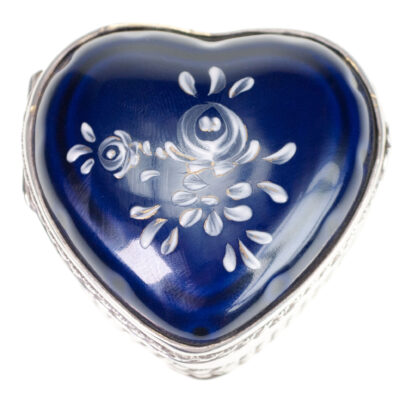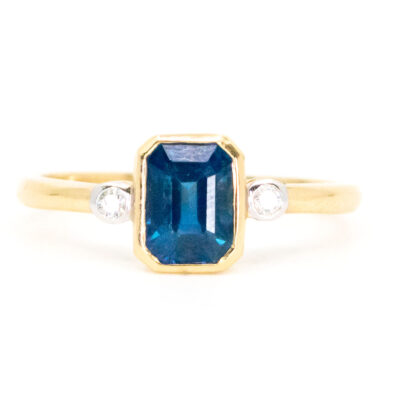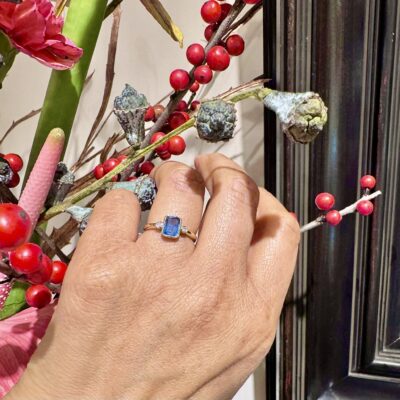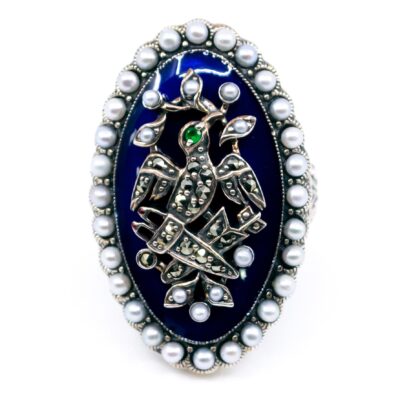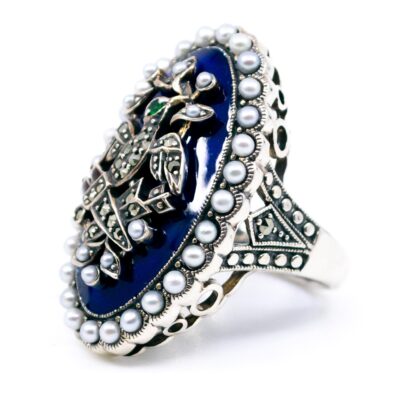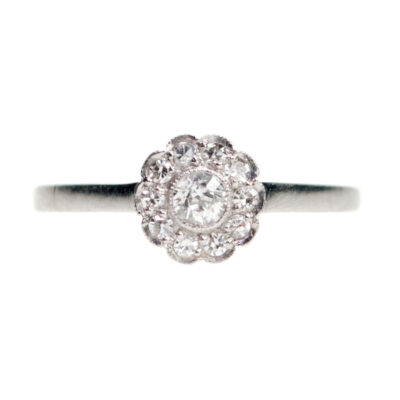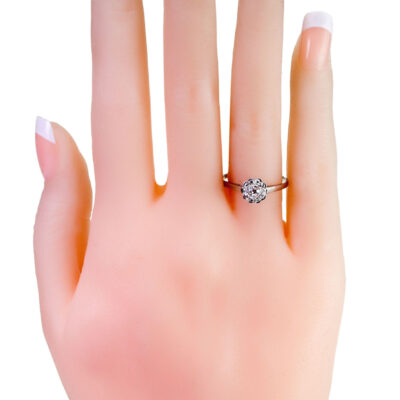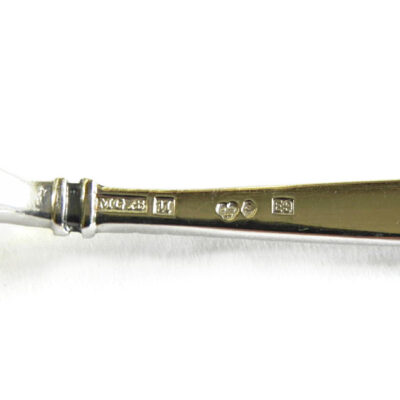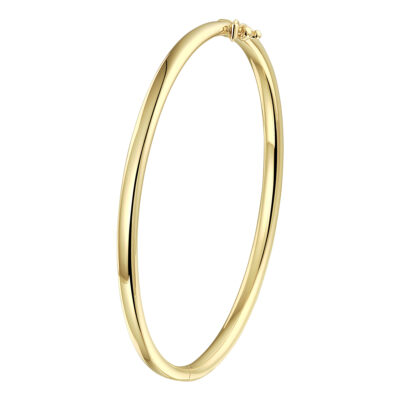Bourdois & Bloch were known for producing high-quality porcelain ceramics in Paris. These candlesticks are a magnificent example of their work and would make a beautiful addition to any collection. The porcelain material gives them a delicate and elegant appearance, while the craftsmanship of Bourdois & Bloch ensures that they are of the highest quality.
Details: Ceramic, Candlesticks.
Dimensions: h: 22 cm x 10 cm.
Weight in grams: 800.
Condition: Very good condition – slightly used with small signs of wear.
Shipping and Pickup: This magnificent piece ships from our store located in the center of Amsterdam, The Netherlands. We offer both registered shipping and local pickup at our store. In the case of local pickup, any applicable shipping costs will be refunded.
About Us: Add some sparkle to your style with Binenbaum.com. We offer a stunning selection of antique and vintage jewelry that you won’t find anywhere else. From timeless rings and dazzling necklaces to unique brooches, we have something for every taste and occasion. Visit our website today and treat yourself to a piece of history.
| Design Era | |
|---|---|
| Design & Historical Context | Art Nouveau, also known as the Modern Style or or Jugendstil, is a decorative art movement that emerged in the late 19th century and was popular until World War I. It is characterized by its use of flowing, organic lines and naturalistic motifs, such as flowers, plants, and animals, as well as its emphasis on craftsmanship and the use of unconventional materials, such as glass, ceramic, and metal. Art Nouveau jewelry often features intricate and detailed designs, with a focus on curved lines and natural forms. The jewelry is often made of precious metals, such as gold and silver, and may be adorned with gemstones, enamels, and other decorative elements. One of the most distinctive features of Art Nouveau jewelry is its use of elongated, sinuous lines and flowing, organic shapes, which were meant to evoke a sense of movement and fluidity. The jewelry often depicts nature themes, such as flowers, vines, and leaves, as well as abstract and symbolic motifs, such as the female form, which was often depicted in a sensual or romanticized way. Art Nouveau jewelry was popular in many countries, including France, Belgium, Austria, and the United States, and was produced by a wide range of designers and artists, including Louis Comfort Tiffany, René Lalique, and Gustav Klimt. Despite the popularity of Art Nouveau, the movement eventually fell out of favor after World War I, and was replaced by more geometric and industrial styles. However, it has often been revived and continues to influence contemporary jewelry design. |
| Key Materials | |
| Materials & Craftsmanship | Ceramic: The Modern Gem of Durability and Artistry Ceramic, known for its strength, versatility, and smooth finish, has become an increasingly popular material in the world of contemporary jewelry. Unlike traditional ceramics used in pottery, jewelry-grade ceramic is made from advanced, high-tech materials like zirconia-based compounds, which are fired at extremely high temperatures to create a durable, lightweight, and scratch-resistant product. Historically, ceramics have been used in various forms of art and functional objects for thousands of years. However, the use of ceramic in jewelry is a more recent innovation, driven by advances in materials science that allow for the creation of strong, wear-resistant ceramic that can be shaped into intricate designs and polished to a high sheen. In modern jewelry, ceramic is appreciated for its sleek, modern look and its ability to be crafted into a wide range of colors and finishes. It is most commonly found in black, white, and metallic shades, although vibrant colors are also available. Ceramic is often used in rings, bracelets, and watches, where its smooth surface and durability make it ideal for everyday wear. Its hypoallergenic properties also make it a great choice for those with sensitive skin. Ceramic jewelry is often combined with other materials, such as metals or gemstones, to create striking contrast and texture. Its lightweight nature makes it comfortable to wear, while its resistance to scratches and fading ensures that it maintains its appearance over time. Ceramic is more than just a material; it is a symbol of modern innovation and design. Its combination of durability, versatility, and contemporary appeal makes ceramic jewelry a stylish and practical choice for those looking to embrace a modern aesthetic without sacrificing comfort or quality. Whether in sleek, minimalist designs or bold, statement pieces, ceramic adds a touch of modern elegance to any jewelry collection. |
| Dimensions | h: 22 cm x 10 cm |
| Weight (in grams) | 800 |
| Condition | Very good condition – slightly used with small signs of wear |
By following these tips, you can enjoy your precious jewelry for many years to come.
Related Products
-
Enamel Porcelain Silver Heart-Shape Box 827-0841
€ 595,00 VAT incl. (where applicable) -
Diamond Sapphire 14k Rectangle-Shape Ring 17009-9059
€ 1.795,00 VAT incl. (where applicable) -
Silver “Lady In Sled” Miniature 13866-2970
€ 225,00 VAT incl. (where applicable) -
Emerald Enamel Marcasite (Pyrite) Pearl Silver Figural Ring 14182-1517
€ 375,00 VAT incl. (where applicable) -
Diamond Platinum Cluster Ring 5651-4767
€ 1.695,00 VAT incl. (where applicable) -
Diamond 14k Cluster Ring 15783-8632
€ 1.495,00 VAT incl. (where applicable) -
Silver Markströms Guldsmeds Spoon Set 7879-2498
€ 695,00 VAT incl. (where applicable) -
14k Bangle Bracelet 17952-9352
€ 1.595,00 VAT incl. (where applicable)
- Home
- Collection
- Fine Jewelry
- Silver Jewelry
- Silverware
- Boxes
- Candlesticks
- Salt and pepper shakers
- Miniatures
- Salt cellars
- Spoon Set
- Condiments
- Frames
- Napkin Ring
- Spoon
- Oddities
- Cups
- Vases
- Cutlery
- Serving Spoon And Cake Server
- Candlesticks
- Baskets
- Hanukkiah
- Spice Tower
- Yad
- Tea Set
- Sugar Castor
- Napkin Rings
- Wine Bottle Coaster
- Wine Stopper
- Tea Pot
- Jugs
- Rattles
- Hip Flask
- Miscellaneous
- Rings 💍
- About
- Contact





